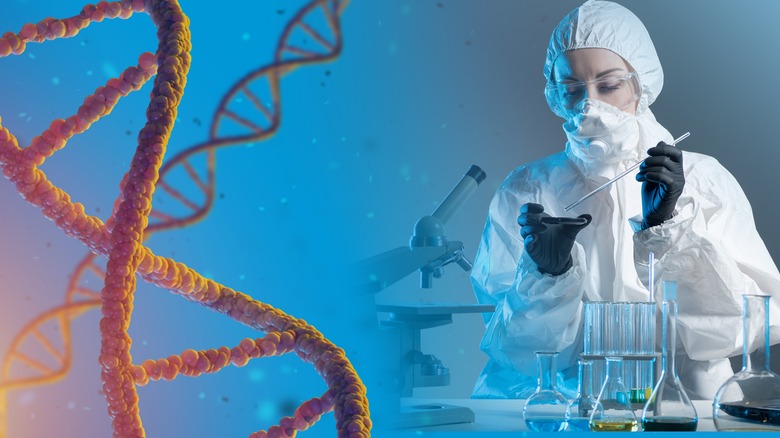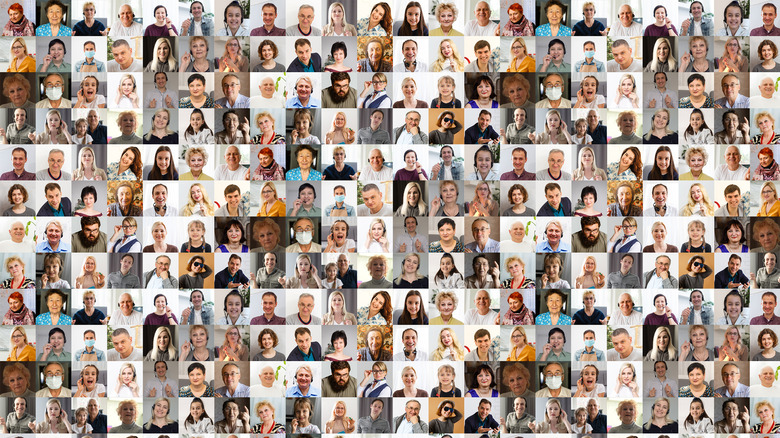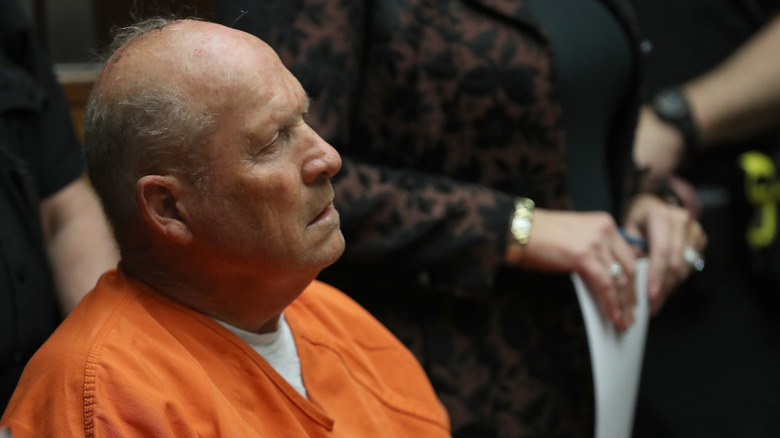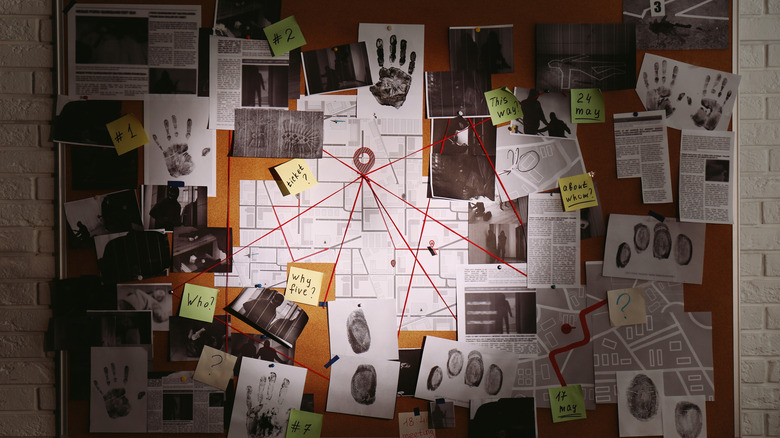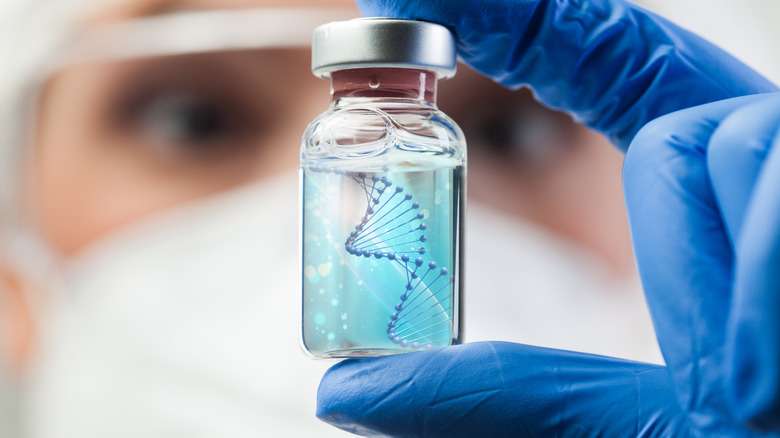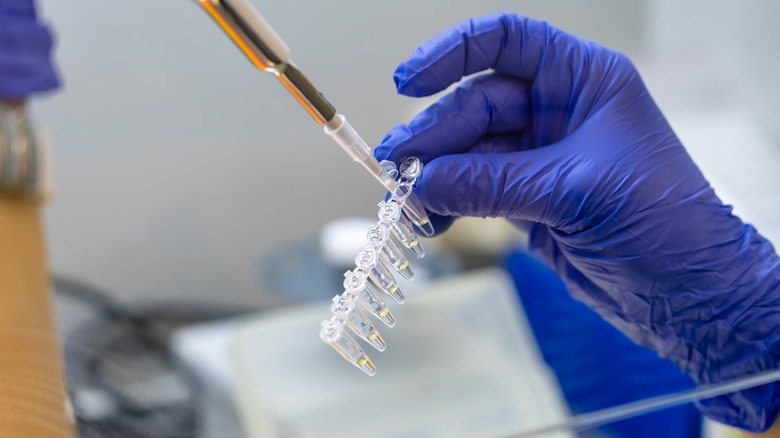How Many Cold Cases Have Been Solved Because Of Genetic Genealogy Testing?
Back in 1958, researchers James Watson and Francis Crick discovered the basic, double-helix structure of the DNA molecule, forever changing our understanding of genetics (via National Library of Medicine). In addition, this discovery paved the way for advances in DNA technology, which have led to things like commercial ancestry DNA testing and the use of DNA in forensics — solving crime by matching the DNA found at a crime scene to a suspect's DNA.
In the past few years, those two technologies have merged, in a manner of speaking, providing police with a new method of solving crimes. This is done not by identifying a suspect directly via his or her own DNA, but by identifying people who may be related to a suspect via DNA analysis and going from there. "The power of this new partnership between genetic genealogy and law enforcement has unlocked one of the biggest, if not the biggest, crime-fighting breakthroughs in decades," notes genealogist CeCe Moore, via the Forensic Technology Center of Excellence.
As of September 2022, this avenue of investigation has led to the resolution of several hundred criminal cases once considered cold (via Phys.org).
How Forensic Genetic Genealogy Works
There are two methods that police can use to identify a criminal suspect through DNA, according to Genealogy Explained. The one we're all most familiar with, and which is bound to inform the plot of at least one TV procedural per week, is the most direct. In essence, a criminal suspect leaves behind something containing their DNA — a strand of hair, for example, or a drop of blood. That sample is compared to a sample from a possible suspect — perhaps law enforcement got a warrant to obtain one by, say, taking something from their trash. If the DNA is a match, then authorities have their man, so to speak.
The second method is more indirect. In essence, authorities take a DNA sample from a crime scene and then compare it to the millions of samples in a nationwide database of criminal genetics — the Combined DNA Index System, or CODIS — as well as those from regular people who used commercial ancestry DNA tests and whose profiles were uploaded into a database called GEDmatch (per the International Symposium on Human Identification). Authorities will then use this to match people who may be genetically close to the suspect — siblings, parents, cousins, and so on. (Do note that the preceding explanation is bare-bones and leaves out considerable scientific, procedural, and legal nuance.)
A Singular High-Profile Case
Perhaps the most high-profile case of a crime being solved through forensic genealogy is that of Joseph James DeAngelo Jr. (above), also known as the "Golden State Killer." As Australia Broadcasting Corporation reports, authorities suspected that one man was responsible for 13 murders and at least 50 sexual assaults, going back to the 1970s. Yet for decades, he eluded capture — that is, until forensic genealogy came into play.
In 2018, authorities used genetic material obtained from crime scenes dating back to the 1970s and 1980s and compared it to samples in a database known as GEDmatch. As it turns out, that database contained the DNA profiles of about 20 people related to the suspect. Then, authorities compared notes with what was known and what was suspected about the Golden State Killer and, long story short, covertly secured a DNA sample from Joseph Dames DeAngelo Jr. When it matched, a decades-old cold case was solved, and this new(ish) method of crime-solving became front and center in the national conversation. As for DeAngelo, he was convicted and sentenced to life in prison without the possibility of parole, according to NPR.
If you or anyone you know has been a victim of sexual assault, help is available. Visit the Rape, Abuse & Incest National Network website or contact RAINN's National Helpline at 1-800-656-HOPE (4673).
More than 400 Cold Cases Solved
"Golden State Killer" James DeAngelo Jr. might not have been the first person to be tied to a crime (or series of crimes) thanks to forensic genealogy, nor would he be the last. Two weeks earlier, authorities announced a breakthrough in a decades-old cold case thanks to forensic genealogy, although in this case, the criminal behind the crime remains elusive. Specifically, as Phys.org reports, authorities announced in April 2018 that they knew the name of a murder victim whose identity had eluded them. Back in 1981, the strangled body of a young woman was found along the side of a road in Ohio (via DNA Doe Project). For decades, she was known only as "Buckskin Girl," but in 2018, authorities — thanks to forensic genealogy tying the victim to a known relative — were able to identify her as Marcia L. King. Though authorities now have her name, her murder remains unsolved, according to the Cincinnati Enquirer.
Meanwhile, as of September 2022, it appears that "more than 400" criminal cases have had breakthroughs thanks to forensic genealogy (per Phys.org). In a very recent case, DNA in public genealogy cases was helped to identify the suspect in the Moscow, Idaho murders of four college students, according to The Guardian.
It's Not The Be-All, End-All Of Crime Solving
You may be tempted to conclude that forensic genealogy is a scientific boon that is going to open the door to crimes being solved left and right. However, it's not that simple — for a variety of reasons. A 2022 report by the Forensic Technology Center of Excellence is pretty clear from the get-go that the process is limited. "Searching DNA profiles against the Federal Bureau of Investigation (FBI)'s Combined DNA Index System (CODIS) is a critical first step toward finding investigative leads — but these searches may not always yield probative matches," the report notes.
Phys.org notes that, even when the process works, it can be time-consuming. It can take a year or more for the process to yield a result — if it yields one at all — and in some cases, authorities may give up or run out of funding. Nevertheless, genetic genealogist Colleen Fitzpatrick is bullish on this technology becoming more widespread and more useful in law enforcement. "I think in the near future, it will be the evidence that will determine the outcome of the case," she said, via KSAZ.
Privacy Concerns
When law enforcement uses DNA information from regular people who submitted to an ancestry DNA test through a commercial company, that means that individuals' private DNA information is being examined and used to solve crimes. ACLU staff attorney Vera Eidelman isn't feeling it. "In submitting our DNA for testing, we give away data that exposes not only our own physical and mental health characteristics, but also those of our parents, our grandparents and, as in [Joseph James] DeAngelo's case, our third cousins — not to mention relatives who haven't been born yet," she said, via KSAZ.
Officially, law enforcement should have to secure a warrant before searching these databases, according to the Los Angeles Times. Further still, the policies of commercial ancestry DNA companies as regards this matter are all over the place; some require users to opt-out of having law enforcement use their DNA, while some only provide it when there's a warrant or subpoena. Unofficially, in at least one case — that of the Golden State Killer — the rules were bent quite a bit, to put it mildly. Specifically, there was no warrant, police used a fake profile, and at the time, FamilyTreeDNA didn't even tell users that law enforcement could potentially use this information in investigations.
"We should be able to access the benefits of technological advances without giving up our rights," notes the ACLU.
